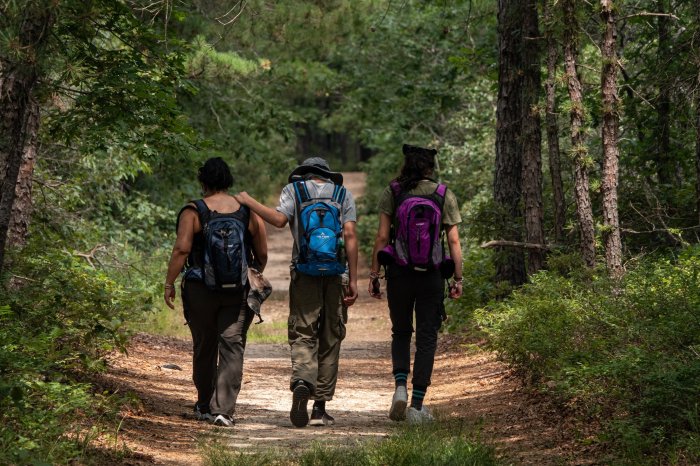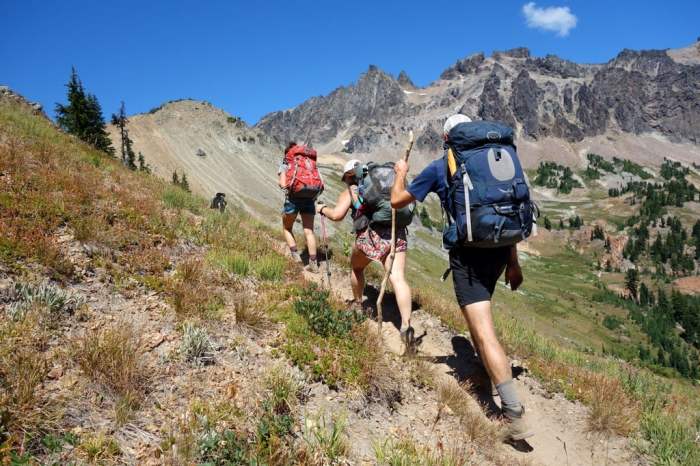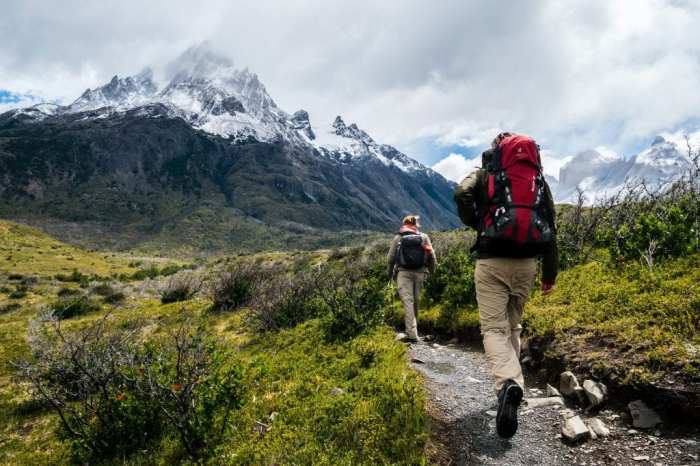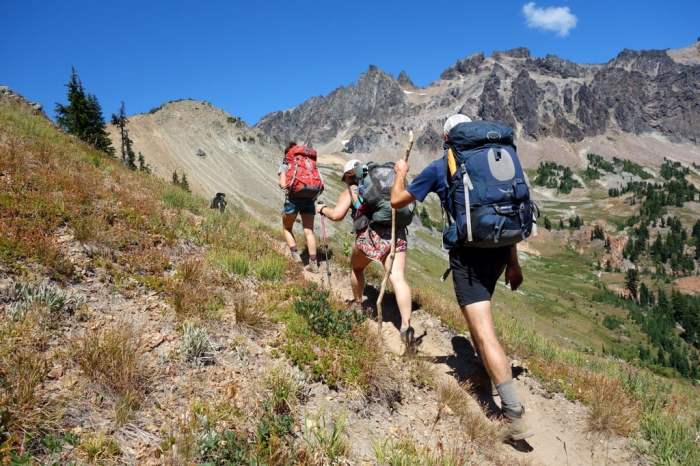Appalachian Trail with baby: Embarking on this iconic trek with a little one presents unique challenges and rewards. This comprehensive guide will equip you with the knowledge and strategies needed to navigate the trail’s complexities, ensuring a memorable experience for both you and your little adventurer. From meticulous planning to essential safety precautions, we’ll cover everything you need to know to conquer the Appalachian Trail with your baby.
We’ll delve into essential gear, carrier options, and detailed itineraries, helping you plan every step of the way. Expect insights into lodging, food, and support systems along the trail. Safety and health considerations, along with emergency preparedness, will be a focal point, allowing you to enjoy the journey with peace of mind. Finally, we’ll discuss how to incorporate your baby’s needs and interests into the hiking experience, and ways to minimize your environmental impact.
Planning & Preparation
Embarking on the Appalachian Trail with a baby requires meticulous planning and preparation. This journey demands a unique blend of resilience, adaptability, and meticulous attention to detail. Beyond the usual trail essentials, parents need to carefully consider the needs of their little one, ensuring a comfortable and safe experience for both of you. It’s not just about hiking; it’s about creating memories while ensuring the well-being of the entire family.
Essential Gear
Careful selection of gear is paramount for a successful Appalachian Trail adventure with a baby. Consider the following categories for a comprehensive list:
- Baby Gear: This includes a comfortable and supportive baby carrier (crucial for extended periods of hiking), a lightweight stroller (for rest stops and potentially less strenuous sections), diapers, wipes, baby food, formula or breast milk, and a portable changing mat. Adequate clothing for varying weather conditions is also essential.
- First Aid: A well-stocked first-aid kit is crucial, encompassing bandages, antiseptic wipes, pain relievers, any necessary medications, and any personal medical items for the baby. A comprehensive first-aid kit for adults is also necessary, covering a range of possible injuries.
- Personal Gear: Pack lightweight, moisture-wicking clothing for all types of weather. Include layers, rain gear, and extra socks. Consider sturdy hiking boots, a comfortable backpack, a water filter or purification tablets, a lightweight tent or bivy sack, a compass, a map, and a GPS device. A headlamp or flashlight is essential for nighttime use.
Baby Carrier Options
Choosing the right baby carrier is critical for a successful hike. Different carriers offer varying degrees of comfort and support for both the baby and the parent.
- Mei Tai: These carriers are often lightweight and easy to use, offering a close, ergonomic fit for the baby. They can be particularly well-suited for shorter hikes and carrying a baby who isn’t yet very heavy. However, they may not be as supportive for longer treks, especially with a growing baby. The adjustability of these carriers can make them suitable for different ages.
Hiking the Appalachian Trail with a baby? It’s definitely a unique challenge, but totally doable! While planning your backpacking route, why not also check out some of the amazing beaches in India? Best beaches in India offer a completely different kind of adventure, perfect for a relaxing break after the trail. Once you’ve explored the beauty of India, you’ll be even more prepared for the challenges and rewards of the Appalachian Trail with your little one.
- Front Carriers: Front carriers are popular for their ability to keep the baby close to the parent. They are generally comfortable for both the baby and the parent, but some models might not be as supportive for longer hikes with a heavy baby.
- Back Carriers: Back carriers allow the parent to have their hands free for navigation or other tasks. They are excellent for longer hikes, particularly when the baby is older and more comfortable in a more upright position. However, they may not be as suitable for shorter, more challenging terrains.
Itinerary Template
A detailed itinerary is vital for a smooth trip. Here’s a sample template:
- Day 1: Arrive at the trailhead, set up camp, and take a short, easy hike to acclimatize to the altitude and terrain. Plan for plenty of rest time for both you and the baby.
- Day 2-7: Continue the hike, ensuring adequate rest stops, feeding times, and opportunities for baby’s playtime. Consider adjusting daily mileage based on the baby’s energy levels. Include activities like nature walks, playtime in designated areas, and rest stops.
- Day 8: Reach a major rest stop, or a suitable campsite, and celebrate a milestone. Prepare for an extended rest period to recover from the hike and prepare for the next segment of the journey.
Navigating Challenges
Navigating the trail with a baby will present various challenges, but thoughtful preparation can mitigate many issues.
- Elevation Gain: Plan for more rest stops and adjust daily mileage according to the baby’s energy levels. Ensure that the baby carrier and stroller are suitable for the varying terrain. Consider altitude sickness precautions.
- Weather: Pack layers of clothing and be prepared for sudden changes in weather. Carry rain gear and appropriate footwear for different conditions. Ensure baby is dressed in layers, too.
- Terrain: Choose trails that are suitable for strollers or carriers. Be prepared for uneven surfaces and potential obstacles. Evaluate the terrain before embarking on a segment.
Transportation Methods
Transportation to trailheads can vary greatly, influencing the overall planning. Consider these methods:
| Method | Pros | Cons |
|---|---|---|
| Driving | Flexibility, convenience, ability to carry all gear | Longer travel times, potential parking issues, need for a vehicle suitable for transporting a large amount of gear |
| Flying | Faster travel times to distant trailheads, convenient for large groups | Higher cost, potentially limited luggage space, increased travel time to/from airport |
| Public Transport | Cost-effective, can be convenient for some locations | Less flexibility, longer travel times, may require multiple transfers, and limited gear space |
Logistics & Resources
Embarking on the Appalachian Trail with a baby requires meticulous planning beyond the usual considerations. This section delves into the practical aspects of lodging, food, permits, and support systems crucial for a smooth and enjoyable journey with a little one. Careful preparation ensures a comfortable and safe experience for both you and your child.Navigating the trail’s diverse landscapes and the unique needs of a baby necessitate a thorough understanding of the available resources.
This includes researching lodging options, identifying baby-friendly eateries, and understanding the necessary permits and regulations. Knowing these aspects empowers you to make informed decisions and confidently face the challenges ahead.
Hiking the Appalachian Trail with a baby? It’s definitely a unique experience, requiring careful planning. Finding the perfect spot to rest and recharge after a day of hiking is key, and that’s where exploring the best neighborhoods in San Antonio comes in handy. Best neighborhoods san antonio offer diverse options, from family-friendly parks to cozy cafes, providing crucial support for the whole family.
Ultimately, whether it’s the Appalachian Trail or another outdoor adventure, having a well-equipped and supportive environment makes the experience significantly more enjoyable for everyone.
Lodging Options
Suitable accommodations for families with babies along the Appalachian Trail vary greatly. Consider a mix of options for flexibility and comfort. Many hostels and campgrounds offer family-friendly cabins or tent spaces, providing essential amenities like kitchens for meal preparation. Finding suitable lodging depends on your preferences and budget. Look for locations near trailheads or established towns to minimize travel time and access amenities.
Baby-Friendly Restaurants and Food
Finding nourishing and convenient food options for your baby along the trail requires advance planning. Many restaurants in towns along the trail offer kid-friendly menus. Consider bringing baby food or formula in addition to familiar favorites to meet your child’s nutritional needs. Pack snacks and meals for those sections where dining options are limited. Flexibility and preparation are key when it comes to providing appropriate food for your baby.
Planning and Booking Campsites
Securing campsites in advance is critical for a successful AT journey with a baby. Reservations are essential, especially during peak season. The Appalachian Trail Conservancy website and various campground reservation systems are useful tools for finding and booking available campsites. Be prepared to adapt your itinerary if needed. The ability to make reservations and plan ahead significantly reduces the risk of encountering unexpected situations.
Support Systems
Local guides and medical facilities are vital resources for families on the Appalachian Trail. Familiarize yourself with the nearest medical facilities along your route. Local guides can offer invaluable insights into trail conditions, potential hazards, and helpful resources. They can also provide valuable information about baby-friendly accommodations and restaurants. A thorough understanding of these support networks provides reassurance and aids in planning.
Permits, Fees, and Regulations
| Permit Type | Fees | Regulations |
|---|---|---|
| Backcountry Camping Permit | Vary by location, typically a small fee per night. | Obtain permits in advance, follow campsite regulations. |
| Hiking Permits | Generally, no specific hiking permits for babies, but check trail specific regulations. | Adhere to trail rules for safety. |
| Specific Trail Permits (e.g., for specific sections) | Variable; check for each section. | Regulations vary by trail section. |
This table Artikels common permits and regulations. Always verify the specific rules and regulations for the sections of the Appalachian Trail you plan to hike. This includes details on fees and required documentation. Adhering to these regulations ensures a respectful and compliant experience.
Safety & Health
Hiking the Appalachian Trail with a baby presents unique challenges to safety and well-being. Careful planning and preparation are crucial to mitigating potential risks and ensuring a healthy and enjoyable experience for both you and your little one. This section will detail potential health risks, essential first-aid supplies, weather preparation, emergency preparedness, and communication strategies.
Potential Health Risks and Preventative Measures
Hiking with a baby introduces specific health concerns beyond those encountered on a typical backpacking trip. Altitude sickness, heat exhaustion, and dehydration are heightened risks. Infectious diseases, especially those impacting young children, also need consideration. Careful planning and proactive measures are key. Proper acclimatization to altitude, staying hydrated, and using sun protection are vital.
Planning an Appalachian Trail trek with a baby? It’s a huge undertaking, and while navigating the trail is challenging, don’t forget to prioritize your tech security! Remember to check out tsa cybersecurity tips warning tech mistakes before you go, ensuring your devices are protected from potential threats. Keeping your digital life secure is crucial for peace of mind during this incredible adventure with your little one.
Ensuring your baby has received all recommended vaccinations and is up-to-date on preventative medications is also important. Consult your pediatrician for specific advice tailored to your baby’s needs.
Essential First-Aid Supplies and Procedures
A comprehensive first-aid kit is essential. Beyond standard supplies, include items specific to infants and young children, such as baby pain relievers, anti-diarrheal medications, and any necessary allergy medications. Know how to treat common hiking injuries like blisters, scrapes, and insect bites. Practice basic first-aid procedures with your baby, and ensure you are familiar with administering any necessary medications.
Understand the importance of recognizing and responding to potential medical emergencies like allergic reactions, seizures, or respiratory distress.
Weather Forecasting and Preparation
Accurately predicting and preparing for changing weather conditions is critical. Utilize multiple weather sources, including online platforms, apps, and local forecasts. Monitor temperature fluctuations, precipitation patterns, and wind speeds. Understand how these factors can impact your baby’s comfort and safety. Pack appropriate clothing layers for both you and your child to adapt to temperature shifts, and consider bringing extra layers, waterproof gear, and a rain cover for your baby’s carrier.
Emergency Preparedness Plans
Developing a comprehensive emergency plan is paramount. This includes identifying potential hazards along the trail, outlining escape routes, and establishing communication strategies. Consider carrying a satellite messenger or a personal locator beacon (PLB) to alert emergency services in case of a major incident. Practice emergency procedures with your baby to ensure everyone is familiar with the plan and can react effectively.
Familiarize yourself with emergency response protocols in the area you are hiking.
Communication Strategies
Effective communication is crucial in an emergency. Designate a point of contact who will receive updates from you and relay information to emergency services. Establish a communication plan, outlining how you will contact each other, including the contact person and any backup communication methods. Consider a personal locator beacon (PLB) for quick emergency contact. Develop a system for communicating your location to your contact person, including specific trail markers, mile markers, or landmark locations.
Emergency Contact Information and Procedures
| Category | Name/Number | Procedure |
|---|---|---|
| Emergency Contact Person | [Name of contact person] | [Contact number] |
| Emergency Services | [Local emergency services number] | Dial in case of urgent need |
| Healthcare Provider | [Doctor’s name and number] | Contact if necessary for medical assistance |
| Trail Host/Ranger | [Contact information for trail host or ranger] | For trail-specific emergencies or guidance |
Ensure all contact information is readily accessible and updated regularly.
Hike Experiences & Considerations
Embarking on the Appalachian Trail with a baby requires careful planning and a flexible mindset. It’s not just about reaching a destination; it’s about creating cherished memories and ensuring everyone’s comfort and well-being throughout the journey. The beauty of the trail can be enjoyed by the entire family, but it demands a shift in perspective to accommodate the needs of a little one.The Appalachian Trail presents unique challenges for families with babies.
The terrain, distances, and changing weather conditions require parents to adapt their hiking strategies to ensure a positive and memorable experience for everyone. The journey necessitates prioritizing flexibility, pacing, and rest, while keeping the baby’s interests and needs at the forefront.
Adapting Hiking Strategies for a Family with a Baby
Flexibility is paramount. Hiking schedules should be fluid, allowing for unexpected delays or adjustments based on the baby’s needs. Don’t be afraid to cut a hike short if the baby isn’t cooperating or if conditions aren’t ideal. The goal is to enjoy the journey, not to adhere rigidly to a pre-determined schedule. Pacing is key; shorter, more frequent breaks are better than trying to maintain a strenuous pace for extended periods.
This approach ensures everyone’s energy levels are managed effectively.
Importance of Breaks and Rest Periods
Regular breaks are crucial for both parents and the baby. Rest periods allow for feeding, diaper changes, and playtime, which contribute to the baby’s comfort and well-being. Moreover, they provide parents with a chance to recharge and maintain their own energy levels. Consider breaks as opportunities to reconnect and enjoy the scenery together. Rest periods for the baby should be incorporated into the daily schedule.
Incorporating Baby’s Interests and Needs
Infants have unique interests and needs. Incorporate these into the hiking experience by allowing the baby to explore the surroundings, taking advantage of opportunities to observe the scenery. Include activities such as pointing out different birds, flowers, or rocks along the way. Pack a variety of baby-friendly snacks and toys to keep the baby entertained. Don’t hesitate to deviate from the planned route if the baby expresses interest in something along the trail.
Baby-Friendly Activities Along the Trail
The Appalachian Trail offers various opportunities for baby-friendly activities. Picnics in scenic locations, with a view of the surroundings, are great opportunities for relaxation. Visiting overlooks with breathtaking vistas can provide memorable moments. Even short strolls through shaded areas offer chances for rest and relaxation. Seek out areas with readily available water sources.
Baby-Wearing Techniques for Hiking
| Technique | Effectiveness for Hiking | Description |
|---|---|---|
| Front Carry | High effectiveness for close interaction and accessibility. | The baby is positioned in front of the parent, allowing for constant interaction and ease of care. |
| Back Carry | High effectiveness for hands-free movement. | The baby is positioned on the parent’s back, allowing for the parent’s hands to be free for navigation. |
| Hip Carry | Moderate effectiveness, offering a balance between hands-free movement and interaction. | The baby is positioned on the parent’s hip, allowing for some interaction while freeing one hand. |
| Ring Sling | Moderate effectiveness, providing good support and adjustability. | The baby is supported by a fabric sling, which wraps around the parent’s body, offering good support. |
Different baby-wearing techniques offer varying degrees of effectiveness for hiking. Front carries offer constant interaction, while back carries provide hands-free movement. Choosing the right technique depends on the baby’s age, weight, and comfort level. Remember to adjust the technique based on the terrain and distance covered.
Environmental & Trail Considerations: Appalachian Trail With Baby

Hiking the Appalachian Trail with a baby requires careful planning to minimize our impact on the fragile environment. We need to be mindful of our footprint, from waste disposal to water usage, and how we interact with the natural world. This section will cover crucial strategies for responsible hiking with a young child, ensuring a positive experience for everyone while preserving the trail’s beauty for future generations.Preserving the pristine beauty of the Appalachian Trail for future generations is paramount.
Careful planning and responsible actions are key to minimizing our impact and ensuring a positive experience for all.
Minimizing Environmental Impact, Appalachian trail with baby
Careful planning and conscious choices are essential to reduce the environmental footprint of a family hiking the Appalachian Trail. Carrying everything out, from food scraps to diapers, minimizes waste in sensitive ecosystems. Choosing eco-friendly gear and minimizing water usage are vital aspects of responsible travel.
- Pack out everything you pack in. This includes food scraps, packaging, diapers, and other waste.
- Utilize biodegradable and compostable alternatives whenever possible.
- Minimize water consumption by planning efficient hydration strategies.
- Choose eco-friendly gear and camping equipment, opting for durable, reusable options over single-use items.
Waste Disposal and Hygiene
Proper waste disposal is crucial for maintaining trail cleanliness. Utilizing designated receptacles or carrying out all waste is a vital part of responsible backpacking. Maintaining personal hygiene without impacting the environment is achievable through mindful practices.
- Utilize designated receptacles or designated waste stations for garbage disposal. When these are not available, pack out all waste.
- Employ biodegradable and compostable alternatives for personal care products and waste materials.
- Dispose of human waste in designated latrines or bury it at least 6-8 inches deep, well away from water sources.
- Practice good hygiene, ensuring handwashing with biodegradable soap and water and using waste disposal bags.
Educating the Baby on Environmental Respect
Early exposure to nature’s wonders and environmental stewardship is valuable. Introducing the concept of respecting wildlife and the environment fosters a lifelong appreciation for the natural world. Through play and interaction, children can learn the importance of responsible behaviour.
- Use nature play as an educational tool, introducing concepts of wildlife and environmental respect.
- Demonstrate proper interactions with wildlife, emphasizing observation from a distance and avoiding disturbing their habitats.
- Use storytelling and nature-based games to instill environmental awareness and respect.
- Show the baby how to properly dispose of waste and conserve resources.
Baby-Friendly Trail Sections
Certain sections of the Appalachian Trail offer more accessible and comfortable options for hiking with a baby. Factors like trail width, elevation changes, and proximity to amenities are key considerations.
- Sections with wider trails and gentler elevation changes are generally more suitable for strollers or carrying a baby.
- Areas closer to campsites, trailheads, or water sources provide more opportunities for breaks and resources.
- Consider sections that offer amenities like restrooms, water sources, and designated campsites.
Trail Maps and Resources
Comprehensive trail maps and available resources can aid in route planning and ensure a smooth hike. Understanding the terrain, water sources, and amenities along the way is important.
| Resource | Description |
|---|---|
| AT Official Website | Provides detailed trail maps, information on trail conditions, and available resources. |
| Hiking Guides | Offer insights into specific trail sections, potential challenges, and helpful tips. |
| Local Parks/Recreation Departments | Provide information on permits, regulations, and resources within specific sections of the trail. |
Epilogue

Hiking the Appalachian Trail with a baby is a significant undertaking, demanding careful planning and preparation. This guide provides a roadmap for a successful adventure, offering insights into gear, logistics, safety, and the unique experience of sharing this incredible journey with your little one. Remember, flexibility, a positive attitude, and a deep respect for the environment will be your greatest allies.
With careful consideration and planning, you can create lasting memories while exploring the Appalachian Trail with your baby.







